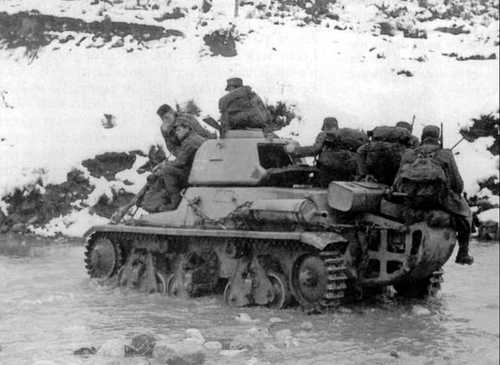
German Forces
To the Nerevtna.
Soldiers of 7 SS Volunteer Mountain Division, "Prinz Eugen" take a ride across a Bosnian river in the early stages of "Operation White" (Fourth Anti-Partisan Offensive, January-March, 1943), clinging to one of the Division's French-built Hotchkiss H-39 light tanks. "Prinz Eugen" was, supposedly, a volunteer division composed of Balkan ethnic Germans. As was usual in such cases, officers and, to a very large extent, NCOs were supplied from native German Waffen-SS formations. In practice, and unlike the situation regarding the recruitment of west European volunteer "Germanic" Waffen-SS formations, little enough respect was paid to the "volunteer" principle in this case; a large proportion of the Division's rank-and-file was made up of unenthusiastic ethnic German conscripts, a precedent for the way "Volksdeutsch" populations in the East would be treated in the formation and maintenance of later "volunteer" SS units. One similarity with the "Germanic" divisions was the initial bad relations between native German officers and NCOs and their Balkan "brothers", many of whom did not even speak German, and who were generally regarded as second-class Germans by their metropolitan superiors. The divisional commander, Artur Phleps, a hardened veteran of WW1 (with the Austria-Hungarian Army) and himself an Austro-Romanian-born "Volksdeutsch", sought to suppress this discord, and eventually seems to have been reasonably successful, albeit with the personal assistance of the Reichsfuhrer-SS. In spite of these initial difficulties, "Prinz Eugen" functioned well as an anti-Partisan unit, playing an important and forceful part in anti-Partisan operations in the Balkans from late-1942 until the expulsion of the Germans by the Soviet Red Army in 1945. In a postwar interview, top SS administrator Obergruppenfuhrer Karl Wolff identified "Prinz Eugen", along with the "Florian Geyer" cavalry division as, in his opinion, the most impressive anti-Partisan units of the Waffen-SS. As for "Fall Weiss" - this culminated with the Partisan Army pinned against the Nerevtna river, but escaping by tricking the German/Italian command as to their intentions, wrong-footing the latter and crossing the river by way of a bridge (which they had blown up as part of the deception, but later repaired temporarily), allowing them to cross the river and annihilate the weak Serb Cetnik forces guarding the western bank (the Cetniks were going through one of their ostensibly pro-German phases at the time). Although they had suffered heavy casualties, Tito and the Comrades as a force lived to fight another day, establishing themselves in western Bosnia to recover. The Fifth Anti-Partisan Campaign (Fall Schwartz) soon followed ... Best regards, JR.
3567 Views
5/22/2013
